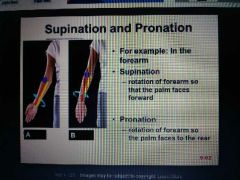![]()
![]()
![]()
Use LEFT and RIGHT arrow keys to navigate between flashcards;
Use UP and DOWN arrow keys to flip the card;
H to show hint;
A reads text to speech;
37 Cards in this Set
- Front
- Back
- 3rd side (hint)
|
Define Ligament |
Tough, fibrous band of connective tissue that supports internal organs and holds bones together properly in joints |
C......ve t.....e s....ts o....ns & h....s b....s |
|
|
Define Tendon |
Tough fibrous band of connective tissue that connects muscles to bones |
C.....ts m.....s to b....s |
|
|
Individuals with joint laxity or hypermobility should |
Strength surrounding tissues to encourage stability and be cautious during high force and high impact activity. |
|
|
|
Skeletal muscle serves three purposes. What are they? |
1. Pulls on tendons attached to the skeleton which produce movement. 2. Produces tension to maintain posture and sustain body position. 3. Support soft tissue. |
Pulls on _ to produce _ Produces _ to maintain _ Supports _ _ |
|
|
Muscle fascia is a type of fibrous connective tissue that serves three purposes. What are they? |
1. Separates individual muscles and muscle groups. 2. Provides shape to the arranged fibers it contains. 3. Maintains intramuscular tension. |
Separates _ _ and _ _ Provides _ to _ _ it contains Maintains _ _ |
|
|
Myofibrils are made up of: |
Long, cylinder-like fibers. (Muscle cells) |
|
|
|
Myofilaments are protiens within _? |
Myofibrils! These set the action of muscle into motion. Thick myofilaments are known as myosin, then filaments are known as actin. |
|
|
|
Anatomical position? |
Standard reference position for the body used when describing locations, positions, and movements of limbs or other anatomical structures. |
Standard whatty? |
|
|
Sagittal plane |
Dissects the body down the center in two side-by-side halves |
Forward lunge |
|
|
Frontal plane |
Dissects the body into front and back halves |
Cable lat pulldown |
|
|
Transverse plane |
Dissects the body into Superior and inferior components |
Cable trunk rotation |
|
|
Anterior |
In front or placed before |
|
|
|
Posterior |
Located behind a part or toward the rear |
|
|
|
Medial |
At, in, near, or being the center. Dividing a person into left and right halves. |
|
|
|
Lateral |
Position or movement away from the midline of the body |
|
|
|
Proximal |
Situated nearest the point of attachment or origin |
|
|
|
Distal |
Situated farthest from point of attachment or origin usually in reference to limb or bone |
|
|
|
What makes up the axial skeleton? |
Skull, hyoid bone, vertebral column, rib cage. |
|
|
|
How many segments does the skeleton consist of? |
Two, the axial and appendicular skeleton. |
|
|
|
What is the appendicular skeleton? |
The limbs and their respective girdles. |
|
|
|
Flexion |
To bend. In hinge joints, the articulating bones move closer together. In ball and socket joints, the limb moves anterior to the midaxillary line. |
|
|
|
Extension |
To straighten or extend. In hinge joints the articulating bones move away from each other. In ball and socket joints, the limb moves posterior to the mid axillary line. |
|
|
|
Lateral flexion |
Spinal movement to the left or the right, occurs at the neck and the trunk. |
|
|
|
Protraction |
Movement of a structure towards the anterior surface in a horizontal line. The only joints capable of protraction are the shoulder joint and the jaw. |
|
|
|
Retraction |
Movement back to the anatomical position, or posterior to the functional range of motion. The only joints capable of retraction are the shoulder joint and the jaw. |
|
|
|
Dorsiflexion |
Movements of the ball of the foot towards the shin. |
|
|
|
Plantar flexion |
Foot movement towards the plantar surface (ankle extension) |
|
|
|
Pronation |

Rotation of the forearm where the radius and ulna cross. Palms face posterior. |
|
|
|
Supination |
Rotation of the forearm where the radius and ulna face uncross. Palms face anterior. |
|
|
|
Inversion |
Turning of the ankle so the plantar surface of the foot faces medially |
|
|
|
Eversion |
Consists of turning the ankle so the plantar surface of the foot faces laterally |
|
|
|
Abduction |
Movement away from the midline |
|
|
|
Adduction |
Movement toward the midline |
|
|
|
What are the five regions of the vertebral column? |
The cervical vertebrae, the thoracic vertebrae, the lumbar vertebrae, the sacral bone, and the coccygeal bone. |
|
|
|
Which two regions of the spine have a lordotic curvature? |
The cervical and lumbar regions. |
|
|
|
Which two regions of the spine have a kyphotic curvature? |
The thoracic and the sacral regions. |
|
|
|
When the knee passes the plane of the toe during flexion, the action forces undesirable movement of the tibia called what? |
Tibial translation, which disrupts patella tracking. |
|

